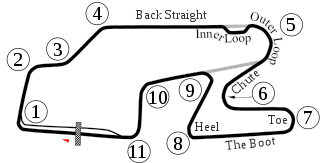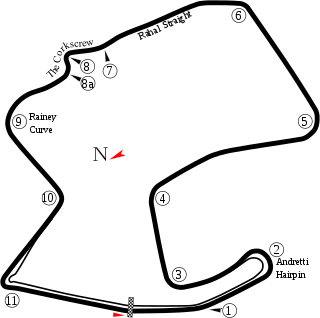The United States Road Racing Championship (USRRC) was created by the Sports Car Club of America in 1962. It was the first SCCA series for professional racing drivers. SCCA Executive Director John Bishop helped to create the series to recover races that had been taken by rival USAC Road Racing Championship, a championship that folded after the 1962 season. For its first three seasons, the series featured both open-topped sports cars and GT cars. Ford and Porsche dominated the Over- and Under-2 Liter classes, respectively. The USRRC ran from 1963 until 1968 when it was abandoned in favor of the more successful Can-Am series, which was also run by the SCCA.

The Lola B2K/40 was a Le Mans Prototype developed in 2000 by Lola Cars International as a cheaper, smaller, and lighter alternative to the similar Lola B2K/10. Although specifically designed to compete in the SR2 class of the Sports Racing World Cup and Grand American Road Racing Championship, it would later be adapted to the LMP675 and LMP2 classes for the 24 Hours of Le Mans and American Le Mans Series. This design was replaced in 2005 by the Lola B05/40 and would last be used in competition in 2006.
The 2000 Grand American Road Racing Championship was the inaugural season of the Grand American Road Racing Championship run by the Grand American Road Racing Association. The season involved five classes: Sports Racing Prototypes I and II and three Grand Touring classes referred to as GTO, GTU, and AGT. 9 races were run from February 5, 2000 to August 17, 2000.
The 1999 United States Road Racing Championship was the second and final season of the revived United States Road Racing Championship run by the Sports Car Club of America (SCCA). The season involved four classes: Can-Am prototypes and three Grand Touring classes referred to as GT2, GT3, and GTT. Five races were scheduled from January 30, 1999, to October 2, 1999, but the series was cancelled after three rounds on June 6, 1999.
The 1998 United States Road Racing Championship season was the inaugural season of the revived United States Road Racing Championship run by the Sports Car Club of America (SCCA). The season involved four classes: Can-Am prototypes and three Grand Touring classes referred to at GT1, GT2, and GT3. Five races were run from January 31, 1998, to August 23, 1998.

The 1999 FIA GT Homestead 3 Hours was the eighth round the 1999 FIA GT Championship season. It took place at the Homestead-Miami Speedway, Florida, United States, on September 26, 1999.

The Bosch Sports Car Oktoberfest was the ninth round of the 1999 FIA GT Championship season. It took place at Watkins Glen International, New York, United States, on October 3, 1999.
The 1969 Canadian-American Challenge Cup was the fourth season of the Can-Am auto racing series. It consisted of FIA Group 7 racing cars running two-hour sprint events. It began June 1, 1969, and ended November 9, 1969, after eleven rounds.

The Six Hours of Watkins Glen is a sports car endurance race held annually at Watkins Glen International in Watkins Glen, New York. The race dates from 1948, and has been a part of the SCCA National Sports Car Championship, United States Road Racing Championship, World Sportscar Championship, IMSA GT Championship, Rolex Sports Car Series and currently the IMSA WeatherTech SportsCar Championship.

The McLaren M6A was a Group 7 prototype race car designed and developed by driver Bruce McLaren, and built by his Bruce McLaren Motor Racing team for their entry in 1967 Can-Am season. As a replacement for the team's M1Bs from 1966, the Chevrolet-powered M6A's improved design earned Bruce McLaren and his team their first of multiple Can-Am championships. After the M6As were replaced by the M8A in preparation for 1968, McLaren and technical partner Trojan–Tauranac Racing developed the M6B which was sold to customers for use in Can-Am as well as other racing series.

The Lime Rock Grand Prix is a sports car race held at Lime Rock Park in Lakeville, Connecticut, United States on the Memorial Day weekend. It had been a part of the Grand-Am Rolex Sports Car Series, SCCA National Sports Car Championship, USAC Road Racing Championship, Trans-Am Series, IMSA GT Championship and United States Road Racing Championship. The revived version in 2017 is for the United States Auto Club Pirelli World Challenge.
The 1967 United States Road Racing Championship season was the fifth season of the Sports Car Club of America's United States Road Racing Championship. It began April 23, 1967, and ended August 20, 1967, after eight races. Mark Donohue won the season championship.
The 1966 United States Road Racing Championship season was the fourth season of the Sports Car Club of America's United States Road Racing Championship. It began April 24, 1966, and ended September 4, 1966, after eight races. GT cars were dropped from the program; only the two sports car classes were run. Chuck Parsons won the season championship.
The 1965 United States Road Racing Championship season was the third season of the Sports Car Club of America's United States Road Racing Championship. It began April 11, 1965, and ended September 5, 1965, after nine races. Separate races for sportscars and GTs were held at two rounds, while seven rounds were combined races. George Follmer won the season championship driving in the Under-2 Liter class.
The 1964 United States Road Racing Championship season was the second season of the Sports Car Club of America's United States Road Racing Championship. It began March 1, 1964, and ended September 13, 1964, after ten races. A second GT class for cars under two liters of displacement was added. Separate races for sportscars and GTs were held at eight rounds, while two rounds were combined races. Jim Hall won the season championship.
The 1963 United States Road Racing Championship season was the first season of the Sports Car Club of America's United States Road Racing Championship. It began February 3, 1963, and ended September 22, 1963, after eight races. Separate races for sportscars and GTs were held at four rounds, while three rounds were combined races, and one round (Daytona) was for sportscars only. Bob Holbert won the season championship, splitting time between the under-two liter sportscar and GT classes.
SCCA Pro Racing is the pro racing division of the Sports Car Club of America. SCCA Pro Racing was formed in 1963, the company is a fully owned subsidiary of SCCA.

The Course de Monterey is a sports car race held annually at WeatherTech Raceway Laguna Seca by the International Motor Sports Association (IMSA). The event began in 1950 as a race on the roads of Pebble Beach, California. In 1951, it was added to the new SCCA National Sports Car Championship. When Laguna Seca Raceway was built in 1957, the races moved there. The event fell dormant after the National Championship was discontinued in 1957, but was revived by the SCCA's new United States Road Racing Championship in 1963. The race fell dormant again in 1969, and was revived in 1973 with the IMSA GT Championship.

The Continental Tire Road Race Showcase at Road America is a sports car race held at Road America in Elkhart Lake, Wisconsin. The event began in 1950, and in 1951 was added to the SCCA National Sports Car Championship. Following a spectator death at the 1952 Watkins Glen Grand Prix, racing on open roads was discouraged, and the race went into hiatus until 1955, when a permanent circuit was opened. In 1963, the race shifted to the new United States Road Racing Championship, until the USRRC's demise in 1968. After an 11-year hiatus, the IMSA GT Championship revived the event in 1979. In 1988, IMSA shortened the race to 500 kilometres (310 mi), and again in 1991 to 300 kilometres (190 mi). The race was shortened to 2 hours in 1992. After a return to a 500-km distance, the race was cancelled in 1994. It was revived once again in 2000, by the Grand American Road Racing Championship, to a 500-mile distance. The race was an American Le Mans Series event from 2002 until 2013, run at varying race distances of either 2 hours and 45 minutes or 4 hours. In 2014 the race joined the schedule of the WeatherTech SportsCar Championship after the merger of the American Le Mans Series and the Rolex Sports Car Series.

The Zerex Special was a sports racing car. Originally a Cooper T53 built for the 1961 United States Grand Prix, it was rebuilt for usage in American sports car racing, and featured open-top bodywork. Initially using a 2.75-litre version of the Coventry Climax FPF straight-four engine, it later used a Traco-Oldsmobile 3.5-litre V8. The car won numerous races throughout its four-year career, being driven by drivers such as McLaren and Roger Penske.








